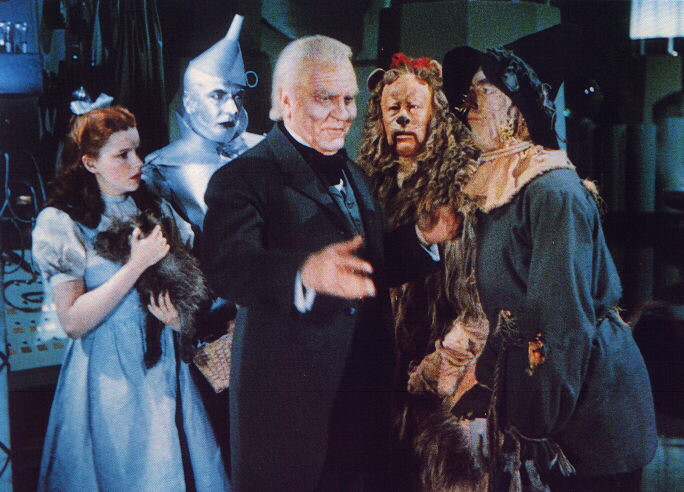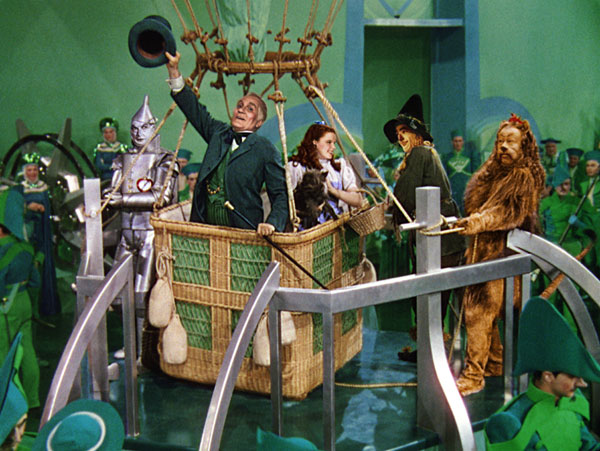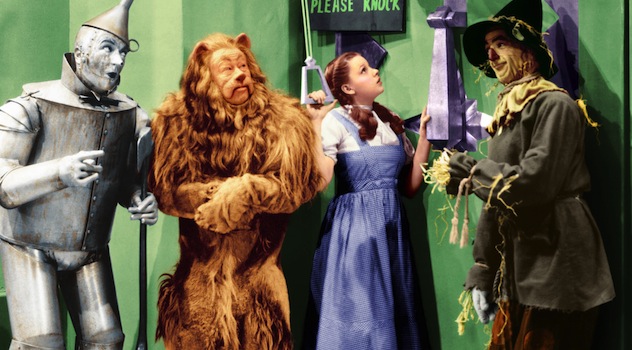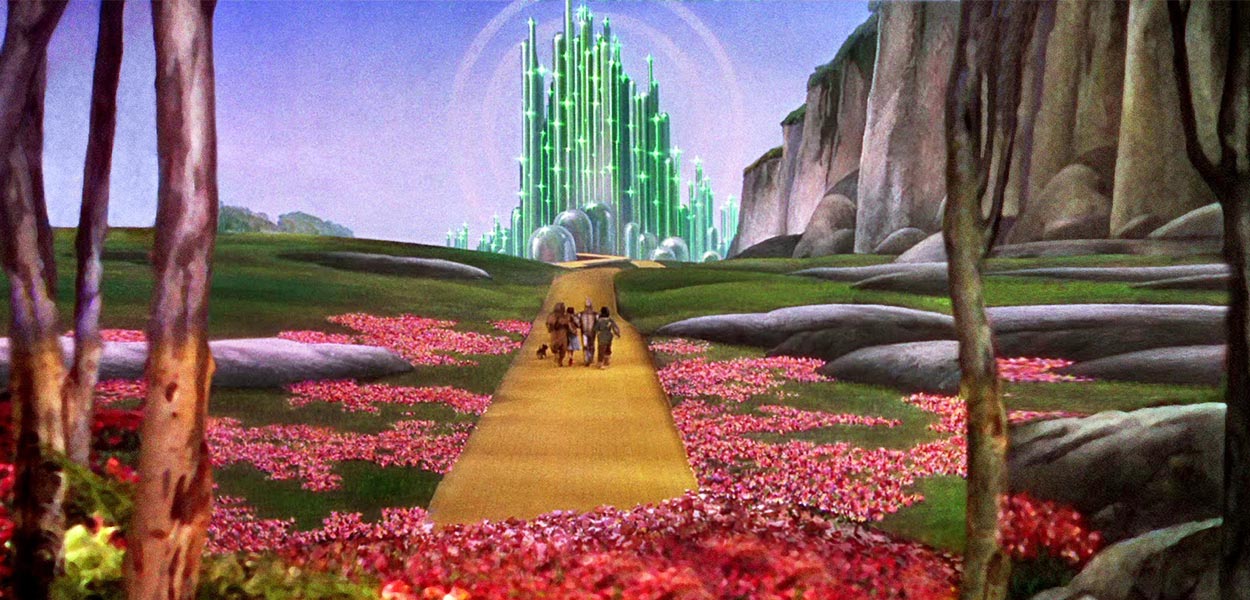6. Intertextuality: Cult Connections

This can be understood as a connection to other films and a specific era. The Wizard of Oz is by no means lacking in its connection to other films, many of these could be regarded as a cross-pollination of cult status.
The film’s relation to Paramount’s Alice has already been well established in this list, one final plus factor to this is that the iconic W.C Field’s who played Humpty Dumpty was very nearly the replacement for the Tin Man when the original, Buddy Ebsen, stepped down from the role citing illness caused by the make-up (Fields’ agent apparently demanded too much money).
It is no secret that Oz was shooting almost back-to-back with Gone with the Wind, sharing not one director but two – Victor Fleming replacing George Cukor on both productions. MGM’s Oz also shares its family tree with the previously mentioned ‘look-a-like’ The Blue Bird. In this instance it is almost as though Fox were trying to recreate an alternative production of The Wizard of Oz using its spare parts.
The film featured Shirley Temple in the lead, apparently an original choice for Dorothy (common rumour also puts Jean Harlow in the role, despite being dead before production began). Also cast as the main antagonist was Gale Sonderguard, the original Wicked Witch of the West, who left owing the role shifting from ‘sly and cunning’ to ‘old hag’.
The Wizard of Oz also interconnects with cult aristocracy in the form of Tod Browning’s circus based horror/thriller Freaks (1930). Browning’s film was banned by the time of the 1939 film’s release but features its lead, Harry Earles as a gruff-faced pipe smoking Munchkin member of the Lollipop Guild (in blue).
His ‘Doll family’ (as they called themselves) siblings, who likewise feature in Freaks, also have roles as munchkins. The connection to sequel’ Return to Oz, and its now cult status, in turn ‘fertilizers’ the cult credentials of the 1939 film, in part due to the cult kudos of Return’s then 11 year-old star Fairuza Baulk.
The issue of star status leads inevitably to The Wizard of Oz’s lead Judy Garland, the troubled screen icon who would die of an overdose at the age of 47.
Nothing appears to chime with the darker side of cult notoriety more than the tragedy of a star who died ‘too soon’, forever ‘destined’ to be immortalised in an iconic youthful role on film, granted Garland made films beyond the first flush of youth but, consider her appeal in relation to James Dean’s trio of films. Few things seem to signal cult status on screen greater than an intertextual connection with tragic realty.
Consider also the ‘cult-ified’ cross-film references throughout cinema, Star Wars (1977), does Obi-Wan appear to melt when Vader strikes him down, likewise a direct reference during Christopher Lloyd’s demise in 1988’s Who Framed Roger Rabbit and the colourful other-worldly mish-mash of characters within Ming’s court in ‘camp classic’ Flash Gordon (1980).
One final tick in this box is the information that the ‘where for art thou Romeo voice during ‘if I only had a heart’ was Adriana Coselotti who voiced Snow White in the 1938 Disney film – an intertexutal reference weaved in from the start. It should be noted here that Baum’s novel is predated by Lewis Carroll’s Alice’s Adventures on Wonderland (1865) – various film adaptations of each doubtless ‘cross-pollinating’ over the years.
The Wizard of Oz transcends into popular culture gaining cult status with every ‘intertextual’ reference. Like a secret (cult) society, if the viewer misses the reference then they aren’t in the gang.
7. Nostalgia: Better Because It’s Not As Good As We Remember it?

A strong factor in The Wizard of Oz’s cult credentials, at the time of writing moving toward its 80th Anniversary, in those years there will have been a great many viewings by a great many people. Consider the many family, friends and group viewings over those years.
The cinematic releases, the VHS, DVD and Blu-ray (re)releases, the holiday screenings on television – each screening accumulating more and more memories, more individual references – all the time the nostalgia factor growing as memories of the film merge with those of family, friends and specific moments of time. It could be stated that the film becomes more about the associated memories and less about the actual content.
Also tying with the intertextiality factor, the film harks back to Cinema’s ‘Golden Age’, the Hollywood studio system and a time when actors were regarded as stars from another world. Running, chronological parallel, to other ‘greats’ such as Gone with the Wind, The Wizard of Oz also comes to symbolise and merge into perceptions particular era.
Nostalgia itself definable as a ‘wistful desire’ or ‘sentimental yearning’ for a bygone period of time, often regarded as recalling the past as being better than it was, Oz’s longevity can be understood as helping to crystallise its cult status by allowing itself to merge with individual memories to form ‘mass nostalgia’. It becomes as much of a ritual or rite of passage as and owing to its frequent holiday screenings both public and private at Easter and Christmas etc.
8. Urban Myth: The Hanging Munchkin

A popular bonus in the 21st Century days of cyberspace – urban myth soon develops into global conspiracy, adding that extra twist to what the viewer sees, or in this instance, thinks they might’ve seen on screen.
Apparently, at the close of the sequence where Dorothy and the Scarecrow have met with the Tin-Man – as the shot shows the three of them viewed from behind disappearing along the yellow brick road – towards the upper left of the screen there is a what appears to be a figure hanging from one of the trees.
The story goes that one of the actors playing a muchkin was rebuffed by a love interest, only to creep on to the set and hang himself in a fit of despair. In tandem with this are the persistent rumours of the muchkin performers’ throwing wild parties – some say drunken orgies.
The hanging munchkin story would have people believe that the cast and crew failed to notice this during both filming and editing, with rumours of it only starting after audiences thought they noticed something during cinema screenings, rumours which grew when the film first became available to the public on home video in 1980 and 1985.
Watching the scene back on the more recent DVD releases and on television, yes, there is an outline of something which could be a figure hanging seemingly upside down from a tree – but – a few moments later a wing extends and it turns out to be a bird, most likely a heron, slightly started as Dorothy and Co skip by.
However, the plot thickens, with sources claiming that the scene has now been ‘doctored’ and the heron added to all versions ever since the 1989 50th Anniversary re-release, a time when restorations and revisions were made including the Kansas sequences returning to their original sepia tint, having only been seen in black and white in any format since the film’s 1955 re-release.
As many point out, the whole rumour rather suspiciously only appeared to take hold in the run-up to the 50th Anniversary re-release with claims that early 1980’s rental copies became sought after (a cult on a mission in themselves) – those who sourced them state there is no difference.
This would put the ‘hanging munchkin’ on a parallel with Three Men and a Baby (1989) and the story of the ‘ghost boy in the haunted flat’ (in fact a wilting cardboard cut-out of Ted Danson’s character from a deleted scene), many state this rumour only appeared when the film had a VHS re-release in the run up to the sequel. Be warned, there are various faked/enhanced clips from both films doing the rounds on YouTube.
The one thing many fail to consider is the near certainty that the trees in Oz are not even real, probably made from a not-too-strong lightweight and portable substance. Regardless, even by discussing the ‘hanging muchkin’, this list adds further fuel to the rumours, stirring up a ‘dark notoriety’ or even ‘intertextual badness’ and in turn further igniting the film’s cult status.
9. Otherness: Counter Cultural Rebellion?

An ‘other’ and in turn ‘otherness’ can be defined as that which differs from ‘the self’ or the ‘perceived norm’, what that norm this is exactly is a matter for debate. For the sake of this list, the norm could be defined as the average 1930/40’s movie-goer and the perceived ‘social norms’ associated with them.
Consider their norms and then consider the world Oz represents in the film, talking scarecrows, lions, trees, tin-men, witches, flying monkeys, all singing –all dancing munchkins and magic – a world which is surely an ‘other’. Even the colours are brighter and bolder than the norm, prime Technicolor brightness, as some mock-posters featuring images from the film suggest: ‘acid trips – occasionally made into movies’.
It could be argued that the film was almost a defiant contrast against the norm, taking proceedings into a rebellious sub or counter-culture territory. Worth recalling here are the moves made to ensure events in taking place in the land of Oz were clearly signposted as a dream for fear of it being too much (too ‘other’) for the popular audience of the time.
Even disregarding the more fantastical elements of the film, Dorothy’s home life is far from the ‘nuclear ideal’, a lone child, perhaps orphaned, living with her Aunt and Uncle (although the reasons behind this are not entirely clear), she could be said to be far from the perceived norm of the time. Likewise, in the land of Oz, there isn’t another ‘self’ like Dorothy, therefore she represents something of an ‘other’ both in Kansas and in Oz.
The film’s appeal for those who themselves feel ‘other’ to the ‘perceived social norm’ is well documented and constitutes a healthy percentage of the film’s cult audience.
The phrase ‘a friend of Dorothy’ connoting homosexuality is now widely known, although there are suggestions the term actually has more to do with the appeal of Garland herself as a troubled star.
Otherness – take your pick – The Wizard of Oz has it by the munchkin’s carriage-full. However, it is worth noting that there is a distinct lack of ethnic ‘other’ to contrast the predominantly white ‘self’ within Oz, a reflection of times in which the film was made perhaps – 1978’s The Wiz (now a cult film itself) featuring Diana Ross, Richard Pryor and Michael Jackson, arguably seeks to address this.
10. A Broader Meaning?

Following on from several points already made in this list, if The Wizard of Oz contains ‘otherness’ then this must constitute a difference to some perceived or established ‘norm’. As philosopher and social theorist Michael Foucault pointed out ‘difference creates meaning’, what exactly any perceptible broader meaning is within The Wizard of Oz is open to the spectator.
Thus providing the film with many of the appealing ‘cult factors’ detailed earlier within the list whilst also bringing it into conflict with those who deem it to oppose particular values or norms. Nothing appear to attract ‘cult audiences’ more than the hint of something subversive.
It is no secret that the original ‘Oz Books’ have been banned, targeted by several groups, in the U.S, over the years. It is reasonable to consider that which may be read into the source material may also be read into the film adaption.
Between 1957 and 1972 Detroit’s libraries banned the book, considering it to have ‘no value’ to modern children. In 1986 several Christian groups in Tennessee opposed the book’s inclusion onto the school syllabus on the grounds that the content ‘seduced children with supernaturalism’ and promoted the belief that human attributes were ‘individually developed rather than God-given’. Speaking animals and women being equal to men was also an issue.
Many have praised the books for the introduction of an ‘American Story’, one that also leads the film into alleged political parallels. In 1967 Henry M. Littlefield published an entire theory regarding the symbolic nature of the story – comparing elements of it to the 1896 U.S presidential election (topical at the time of the book’s publication): The Scarecrow (naive farmers of the west) – the Tin Man (dehumanized factory workers of the east) – the Wicked Witch of the East (Eastern industrialists and bankers who control the people) – the Good Witch of the North (populist New England) – the Good Witch of the South (the populist South) – Dorothy (the good-natured American people) – the Emerald City (Washington D.C) – the Wizard (President Grover Cleveland or Republican Presidential candidate William McKinley) and the Cowardly Lion (Democratic-Populist candidate William Jennings Bryan, known for his ‘cross of gold’ speech (as worn by the Lion in the film).
Of course with the film like the source text – so rich in the kind of ‘otherness’ and potential to invite meaning discussed earlier – it is easy to find within the text anything the viewer chooses.
Perhaps that is an enduring part of the film’s continued appeal, an individual can choose to enjoy/perceive the film in anyway they wish. Ironically, for a film seemingly tailored for a broad popular market, it can be understood as appealing to a broad audience by first appealing to the ‘non-populist’ individual, each finding their own meanings within the production, small cults joining to become one mass cult, a film that both a group of rowdy students, a family with young children and a party of grandmothers might sit through, all finding a reason to be genuinely entertained – a rare and profitable thing indeed.
Author Bio: George Cromack is a tutor at the University of Hull and also Coventry University’s Scarborough Campuses; with a BA in Scriptwriting he also teaches evening classes in Creative Writing, Scriptwriting and Film Studies for the WEA. Working towards his PhD focusing on Folk Horror, he is a keen writer of both prose and script, Cold Calling, a film short written by George premiered in October 2013. Follow him on Twitter @MadBasil.